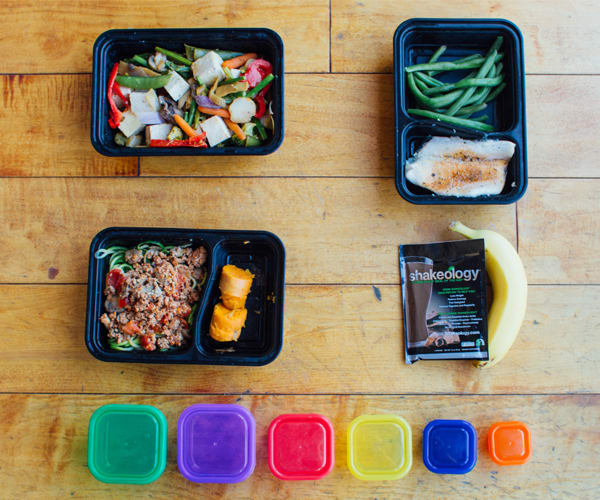4 Ways You Might Be Sabotaging Your Weight Loss

You exercise every day. You eat healthfully. You get plenty of sleep. And you still can’t seem to lose weight or drop a pant size.
We understand your frustration, and you’re not alone.
Common fitness and nutrition mistakes such as not having a realistic idea of how many calories you consume each day and being mostly sedentary outside of your workouts are just a couple of the reasons why people fail to shed pounds despite giving it their all.
Turn things around by eliminating the following weight-loss saboteurs from your daily routine, and then follow our advice to shift your fat loss into high gear.
Why You Can’t Lose Weight: 4 Common Mistakes

1. You don’t have a daily calorie goal
It’s common to think that more exercise = more calories you can eat. But if you’re trying to lose weight and adopt this mentality, you may be adding as many calories as you’re burning — or more.
“Most people have no idea how much they’re eating [or how much damage that’s causing],” says Felicia Stoler, M.S., R.D., a nutritionist and exercise physiologist.
Just because you hit cardio hard today doesn’t automatically mean you can supersize dinner.
To get honest and hold yourself accountable for how many calories you consume, write down everything you eat and how much (yes, even that handful of nuts you’re holding right now), or use a calorie-counting app like MyFitnessPal.
You might be surprised by your daily total.
What should your daily total be for weight loss?
Answering that question is step one for turning things around.
If your current fitness plan doesn’t help you determine a sensible calorie range to target each day, switch to one that does.
Beachbody created two nutrition programs — 2B Mindset and Ultimate Portion Fix — to choose from because what works for a friend may not work for you, and vice versa.
Once you find a plan that fits your lifestyle, stick to it.
Don’t try to accelerate your losses by slashing more calories than what’s recommended. If you don’t eat enough, your body will try to compensate for the excessive calorie deficit by slowing your metabolism.
Your goal is to eat at just enough of a deficit to allow your body to burn through its fat stores.
2. You try to eliminate all carbs
Many exercisers try to eliminate starchy carbs — including whole grains and vegetables like potatoes and corn — when they’re trying to lose weight.
And from all appearances, it works. The scale doesn’t lie. But neither does it tell the whole truth.
When you eat too few carbs, your body doesn’t stock as much glycogen, the stored form of your body’s primary fuel source, glucose.
And since each gram of glycogen is stored with three grams of water, the scale will reflect that reduction in water weight.
But that’s all it is: water weight. So while the lower number might be encouraging, it doesn’t reflect your progress toward your ultimate goal: fat loss.
In addition to losing primarily water weight, cutting back too far on carbs will leave you chronically low on energy, which can hamper your weight-loss efforts by keeping you more sedentary and lowering your workout performance.
The lesson? Don’t be afraid to incorporate carbs, particularly whole grains, veggies, and fruits, into your daily diet.
Just stick to appropriate portions, and don’t forget to include the right amount of protein and healthy fats.
3. You’re not working out hard enough
When you go for a jog or long, slow bike ride, you burn calories as you exercise, but your metabolism settles back to normal soon afterward.
That’s one of the reasons high-intensity exercise — like the kind of metabolic conditioning you’ll find in Beachbody programs such as 80 Day Obsession and Morning Meltdown 100 — is superior for weight loss.
Not only do you burn more calories during every minute you work out, but your metabolism also remains elevated for days instead of hours.
Another advantage of high-intensity workouts: They can curb your appetite.
A study in the International Journal of Obesity looked at sedentary, overweight men who either worked out at a moderate pace for 30 minutes or did high-intensity interval training (HIIT) for the same amount of time.
Those who did HIIT ate less at a subsequent meal, as well as the next day.
Of course, not every workout should be an intense interval session, but fitting in at least one or two a week is smart.
And if you fuel up with a beverage like Beachbody Performance Energize beforehand, you increase your odds of crushing it — and burning more calories in the process.

4. You spend too much time sitting
A sedentary lifestyle is associated with an increased risk of several health problems, including being overweight or obese.
And simply exercising for 30 or 60 minutes a day doesn’t move you out of the sedentary category if you spend most of the other 23 hours in a chair (or bed).
You need to move more throughout the day to affect long-term, sustainable weight loss.
When feasible, walk instead of drive, cycle instead of taking the bus, climb the stairs instead of riding the escalator, carry your bags instead of using a cart, chase your kids at the park instead of sitting on a bench, and generally spend less time on your butt.
Becoming less sedentary, or simply breaking up sedentary periods with light activity can have significant beneficial impacts on waist circumference and body mass index (an indicator of weight) that’s independent of exercise, according to a review in the journal Mayo Clinic Proceedings.
We’re likely not telling you anything you didn’t already know or suspect — now act on that knowledge!
The 10-Second Takeaway
While you may have seen weight loss reduced to a simple mathematical equation — make calories burned greater than calories consumed — there are nuances that can stall your progress, including not knowing how many calories you consume each day, cutting carbs too drastically, not exercising intensely enough, and being too sedentary.
If you make just a few simple tweaks to your approach, you may notice a shift in the way your body responds, and like how that response looks in the mirror.
